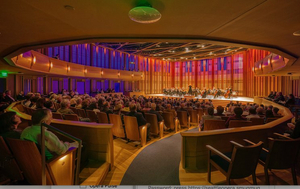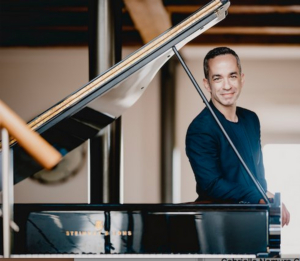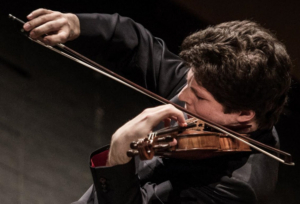Review: LA JOLLA SUMMERFEST Explores Love and Loss at Conrad Prebys Performing Arts Center

On Tuesday, Aug. 20, the highly regarded La Jolla Music Society's Summerfest presented "Love Stories," the penultimate program of their first season at the brand-new Conrad Prebys Performing Arts Center, the Society's new permanent home. Known to aficionados as "The Conrad," the Epstein Joslin-designed Center includes a concert hall, named for founding sponsors Brenda Baker and Steve Baum, a 2000 square foot flexible performance space, a multipurpose meeting room, a spacious courtyard and offices for the Society.
Tuesday's concert took place in the concert hall and was dedicated to the memory of Kay Hesselink. The much-loved, devoted patron of Summerfest over the past many decades was a former chair and a member of the Board of Directors of the festival who, along with her husband John, has hosted numerous Fest artists.
At 513 seats, the Baker-Baum Concert Hall is the perfect size for chamber music in an intimate setting, and the superb acoustics add to the effect. The venue is handsomely wrought, crafted of multiple types of wood, all burnished to a glow, and is sanctuary-like in its atmosphere, imparting an almost religious experience to the listener. The outstanding performers were without a doubt worthy of their new home.
Also new this season is music director and Israeli pianist Inon Baratan, who chose an intriguing program to embody his theme, the power of love and its resultant suffering in music, from the perspective of four composers, two from the early to mid-romantic period and two from the late romantic. The middle two of the four pieces, which portrayed mostly idealized love, were bookended by two wrenchingly emotional works representing both fulfilled and unfulfilled love.

photo Marco Borggreve
The opening work, considered the ultimate in high romanticism, was Wagner's Prelude to Tristan and Isolde, in an arrangement for string sextet by violinist Sebastian Gurtler. The disarmingly ambiguous tonality begins with the famous "Tristan" chord and remains largely unresolved throughout Wagner's opera, until the final chord of the Liebestod that ends the work. This sextet version is lavish in its writing for the strings but, as opposed to the composer's own 16-minute condensation of his opera, Gurtler pares the piece down to a mere 11 minutes, most of which is focused on music from the prelude, with only a few moments of the climactic Liebestod included. This leaves the listener feeling somewhat incomplete.
However, the lushness of the instrumentation and the extraordinary playing of the ensemble of hand-picked musicians who comprised the sextet more than made up for the compositional lack. Standing out among these was violinist James Ehnes, whose elegant, unforced sound and impressive virtuosity set the tone for the vibrant homogeneity put forth by the remaining players: violinist Liza Ferschtman, violists Cynthia Phelps and Richard O'Neill, and cellists Edward Arron and Clive Greensmith. If the Gurtler version felt less emotionally satisfying than the piece in its rendering with the full complement of winds and brass added to the mix, the intense beauty of the ensemble's effulgent sounds, individually and together, was nonetheless powerful.
Robert Schumann's Op. 48 Dichterliebe epitomizes the very definition of romanticism in the vocal genre. Written to celebrate the joys of the intense love he had found with his beloved Clara, each of the songs set to Heinrich Heine's poetry is a rare jewel to be enjoyed and savored, individually and together.
Warm and attractive, with just a touch of that magical Wunderlich timbre and richness, tenor Robin Tritschler's voice was ideally suited in timbre and range for the subtleties of Schumann's poignant score. Pianist Jonathan Biss was much more than an able accompanist; he was a full partner in the interpretation, though sometimes to a fault when the ends of phrases were held overly long or delayed, leaving the listener hanging just a bit too long.
A rare treat was a rendering of Clara Schumann's Three Romances for Violin and Piano, Op, 22, played with tender expression by violin virtuoso Augustin Hadelich. Having Hadelich perform these pieces is a definite bit of luxury casting. Known for his interpretations of fiendishly difficult repertoire, from Brahms and Sibelius to Ligeti, Hadelich manages to make these gentle, very intimate Schumann pieces fit him like a glove.
Watching and listening to this extraordinary artist is like going back in time. There is something about his interpretations that evokes the violinists and composers of the 19thcentury. His stance, mannerisms and lush sound make the listener feel as if he or she is watching and listening to a reincarnated Joachim.

Luca Valentina
The Love Stories theme came full circle with a second sextet, Schoenberg's Op. 4 Verklaerte Nacht, exquisitely performed by virtually the same Festival ensemble as the Wagner, with a slight change in personnel: Ehnes played second violin and Kertschman first; likewise Phelps and O'Neill switched places; and Carter Brey replaced cellist Arron.
Schoenberg composed his tone poemat an important juncture in his musical life, when he was on a path that ultimately led him to the twelve-tone genre. Like Wagner's Tristan, Verklaerte Nacht pushed the envelope of 19th century tonality; it was written in 1899, literally on the cusp of the 20th century, and premiered in 1903 in its original sextet version, which he later arranged for string orchestra. But unlike Wagner's Celtic tale of tragic love, the Richard Dehmel verses on which Schoenberg's tone poem is based portray forgiveness and hopefulness in love.
The musicians were evenly matched, all of them strong and up to the task of executing the considerable technical demands of the piece. Their sound was homogeneous, beautifully blended and consistent; no player overwhelmed or overpowered any of the others. The two violinists' octaves were perfectly in tune, a difficult feat to accomplish with passages that often were placed in the stratosphere. It was a performance that the composer would have been gratified to hear, and a fitting ending to an evening of sublime music making.
Photo credits: Marco Borggreve, Luca Valentina, Steve Uzzell
Reader Reviews
Videos

